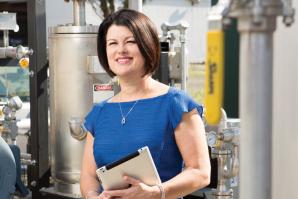Children now have logical reasons for not finishing their brussels sprouts at the dinner table. If they’re thrown away, it could be good for the economy and the environment.
A Gold River company has found a way to turn food scraps into energy — a process called anaerobic digestion — on a commercial scale. With help from state lawmakers, this company and others like it could be poised for growth in California.
Financing, politics and buy-in from power companies have hindered technology advancement and widespread commercialization for anaerobic digestion projects, which create renewable energy by breaking down organic materials. But if more policy groundwork is passed from within the state Capitol this year as expected, the bioenergy sector could see a big increase in community projects, and California could see a big decrease in organic waste going to landfills.
Anaerobic digestion has been around for years and is widespread in Europe. Biogas can be used for electricity, heating or transportation fuel. Using technology developed at UC Davis, Clean World Partners of Gold River has two digesters operating in Sacramento County and another slated to open at the university by September.
The startup’s recent projects are a coup for anaerobic digestion, which has historically accounted for a sliver of the state’s bioenergy production. Only 1 percent of the manure on dairy farms is currently digested, and “food wastes represents similarly underutilized potential resources,” according to the state’s 2012 Bioenergy Action Plan.
The report calls for several agencies to investigate past challenges of failed digesters in the state, including gaps in technology and regulations that hindered profitability, such as air-quality permitting and wastewater disposal. CleanWorld’s system reduces that waste by also producing fertilizer and soil amendments for agriculture, says Shawn Garvey, a company spokesman.
If the state is successful in sorting out its quagmire of environmental regulations for bioenergy projects, the potential to divert organic waste from municipal landfills is huge. Sacramento County and its incorporated areas throw away between 166,600 and 219,300 tons of food waste per year, according to estimates from the County’s Department of Waste Management and Recycling.
Clean World’s second project, located at Sacramento’s South Area Transfer Station, is undergoing an expansion that would allow it to process 40,000 tons of food waste per year at buildout, creating transportation fuel, electricity and fertilizer. When complete, it’s expected to produce enough renewable natural gas to equate to 1 million gallons of diesel and produce 2 million kilowatt hours of electricity, effectively eliminating 5,800 tons of greenhouse gases per year, equivalent to the emissions from 1,000 vehicles or 500 homes.
With California throwing away more than 6 million tons of food scraps per year, the state would need about 150 similar projects to divert food waste from landfills to energy production, Garvey says.
But even if there is a seemingly endless supply of municipal waste, profitability has yet to pencil out for anaerobic digestion in the state.
In order for bioenergy projects to compete in the marketplace, they must have a fuel component, says Dennis Schuetzle, president of Renewable Energy Institute International in West Sacramento. The margin and demand for fuel is greater than for power on the open market. The country has been producing natural gas so quickly, Schuetzle says, that it’s dramatically driven down the cost of power production. So creating a digester project purely to power homes, for example, isn’t viable.
“(Anaerobic digesters) surely can’t compete with natural gas, unless they’re getting credits,” Schuetzle says. “Some of these projects are sexy and they look great, and people will do them because it’s the right thing to do but there’s little benefit economically.”
Clean World used a $6 million grant from the state for its second digester, but Garvey says the company’s long-term plan doesn’t rely on grants or subsidies. Clean World’s business model is comprised of revenue from fees to dump material at a waste processing facility or landfill; biogas capture to produce electricity and transportation fuel; and soil products, such as solid and liquid fertilizer. Clean World has also developed a template approach to its design to reduce the upfront initial investment.
“Currently, there are obstacles as elements of the technology move out of the ‘valley of death’ and become more easily commercialized,” Garvey says. For example, the company can manufacture its systems in modular, prefabricated skids, reducing the capital cost by up to half and producing energy within six months.
The time it takes to get projects up and running is key as environmental regulations have also delayed commercialization. For example, rules from the air and water agencies sometimes contradict each other, and permitting can be a nightmare at the local level. The state’s 2012 Bioenergy Action Plan calls for several state agencies to not only streamline permitting but encourage these projects. Incentives for bioenergy have “been inconsistent or discontinued, while others have failed to account for the additional costs and benefits of biomass,” according to the report.
Mandates also play a role, and California could pass more legislation this year requiring the diversion of organics from landfills. Other states, such as Massachusetts, Rhode Island, Florida and New Hampshire, have been busy with similar laws.
All of this activity at the Capitol spurred the launching of the Bioenergy Association of California earlier this year. Currently, all biomass projects — traditionally using forest and agricultural waste — only account for 2 percent of California’s total electricity supply. The state should expect to see dramatic growth in smaller-scale bioenergy projects, 20 megawatts or less, says Julia Levin, executive director of the association.
“Most of the first generation of biomass, and most of where that 2 percent figure comes from, is much larger sort of central station biomass facilities.” Levin says. “I think we are going to see very dramatic growth in much smaller facilities, not just biomass but anaerobic digestion to produce biogas.”
Historically, the large investor-owned utilities have made it difficult to connect bioenergy projects to the grid. But three key pieces of legislation passed last year to give them a boost. Senate Bill 1122 mandates investor-owned utilities to purchase 250 megawatts from small bioenergy projects by June 1. Two additional laws aid biogas projects, specifically with rules for hooking it up to the grid.
“Recently, we’re hearing about interconnect fees of $1.5 million by PG&E, a clear indicator that they don’t want to service this type of energy,” Garvey says.
While the state is busy mandating investor-owned utilities like Pacific Gas & Electric Co. to purchase more biopower, the Sacramento Municipal Utility District has been a leader in this area for years. Biopower isn’t just good for the environment, it’s also a more reliable source of renewable energy, says Valentino Tiangco, biomass program lead for SMUD. These projects can run continuously, whereas solar and wind projects are intermittent.
SMUD expects to generate more than half of its renewable energy from organic sources this year. The utility uses a mix of direct combustion, landfill gas, wastewater-to-digester gas and dairy biogas systems. However, nearly three-quarters of its renewables from organic waste will come from wood. The methane-gas-derived sources of biomass are expected to produce about 17 percent of its renewable energy.
With California’s push for green energy and Clean World blazing the trail toward profitability of digesters, it could open doors for other companies. In four months, one of the company’s biodigesters was visited by more than 700 academics, entrepreneurs, Fortune 500 companies and representatives of state, federal and foreign governments, including Philippines, Russia, Dubai and China.
Recommended For You

Baiting Clean Tech
How local economic developers are getting creative
On paper it looks like the Capital Region has the makings of a world-class clean-tech hub: access to policy makers at the Capitol, access to innovative research churning out of UC Davis, and housing that’s affordable for green-collar workers. What this equation doesn’t account for, however, is how fast California is losing its competitive edge to other states and the global economy.




